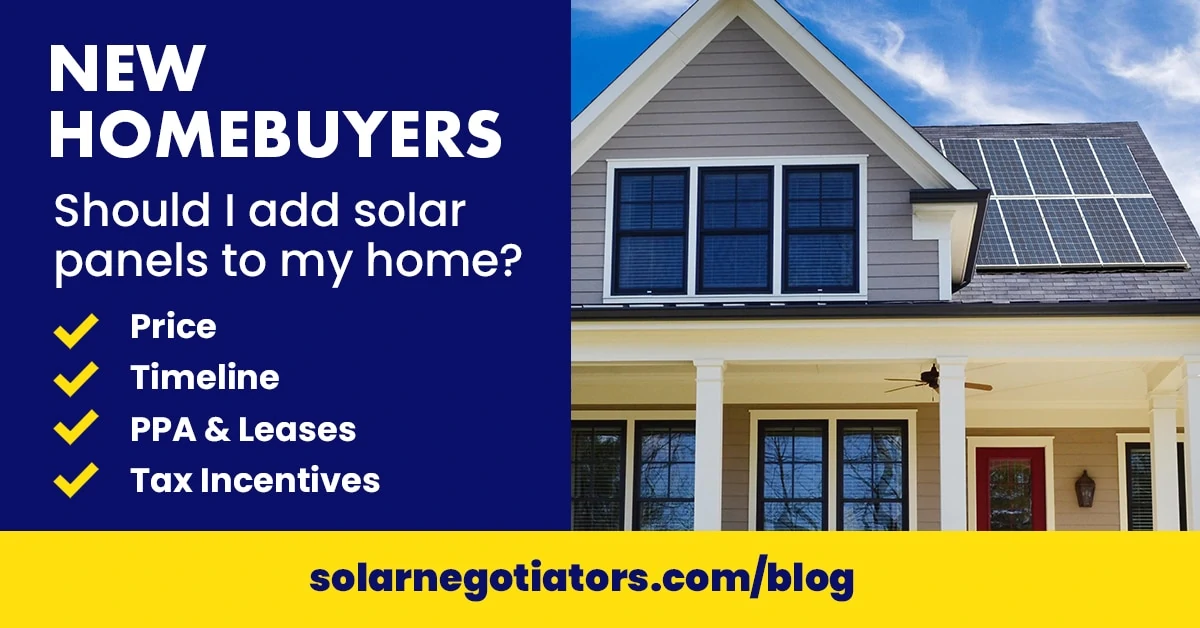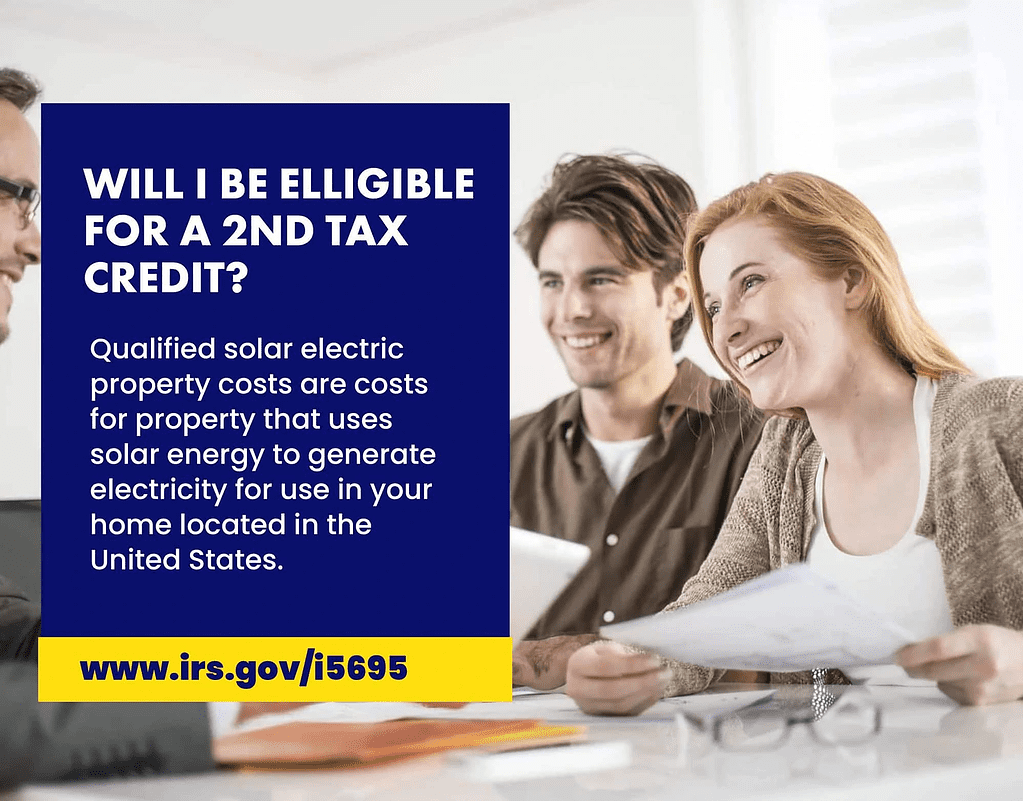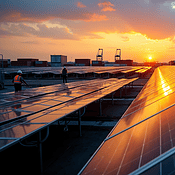
Should I Add Solar Panels to My New Home’s Existing System?
So you’ve purchased a new home! Congratulations. Thanks to the California Solar Mandate, your new home will also have a fully-functioning solar system installed when you move in. The state’s mandate requires that all newly constructed homes with a permit pulled after January 1, 2020, need to have a solar photovoltaic (PV) system as an electricity source.
The cost of your existing solar system is likely already included in your mortgage, making payments seamless and affordable. You’ve already made the smart decision to go solar by purchasing a new home, so the question is no longer if solar is right for you –but rather is the system right for you?

How to know if I should be adding solar panels to my existing system
As stated in An Overview of the California Solar Mandate, Most solar systems are designed to meet the needs of the home, rather than the homebuyer. Therefore, they often fall short of producing what the homeowner needs to offset their monthly electricity usage.
Even if your new home already has a solar system installed, you have the option of adding solar panels to your existing system! Assuming there is room on your roof, additional panels can be a smart choice whether you purchased or leased your existing system. If you were expecting a $0 bill, and are still noticing a debit on your monthly statement each month -you may benefit from adding panels to the existing system. Have you lived in the home long enough to receive a utility bill? An energy advisor can accurately determine a system size with a few months of usage history.
*The statewide solar formula used to size new home solar systems does not account for the extreme heat in the San Joaquin Valley. New homeowners with these undersized solar systems experience balances owed during months of high heat (June, July, August, Sept) on their NEM (Net Energy Metering) statement. However, because solar billing is on a 12-month cycle, they can get shocked with an end-of-cycle TrueUp bill which can be thousands of dollars. For more information, see How to Read Your Annual Solar True-Up (solarnegotiators.com/blog). If you find yourself having higher than expected monthly costs or a shockingly high True-Up bill at the end of the year, your home could be a perfect candidate for adding additional panels.

What is the cost of adding a few panels?
Determining the cost of adding panels to an existing system is done by estimating the power needed to efficiently run your home, and calculating the cost of additions to reach said power level. Then, you will need to compare this amount to what you would be paying on your True-Up bill if you did not add panels to determine if adding more solar panels is worth it for your home.
Looking at this comparison, and the length of time you will be living in the home will help you come to a conclusion of whether or not adding panels to your existing system is worth it.
Step 1: Estimate Power Needed
Existing Solar System Production: 4,954 kWh
Total Annual Consumption: 9,861 kWh
TrueUp Amount: 4,907 kWh = $1,275.00 TrueUp bill each year without new solar addition
System size Needed: Approx. 3.5 kW
Roughly 10 additional high-efficiency solar panels.
Step 2: Calculate the Cost of System Addition
Average cost of solar in 2022: National average $2.77 per watt*
*Disclaimer: These numbers are based on the national average cost of solar, these are not Solar Negotiators’ sales prices.
2.77 x 3,500 kW = $9,695.00
Tax Credit = $9,695 (.26) = $2,520.70
Net Cost of Solar Addition = $7,174.30
Step 3: Compare Energy Cost vs. Solar Installation
True-Up bill each year without new solar addition ($) = $1,275.00
Net Cost of Solar Addition: $7,174.30
Financing Option = Cash = 0 Interest
Average payback period = Net Cost of System Addition ($7,174.30)/True-Up bill each year without new solar addition ($1,275) = 5.6 years
If you are planning to live in the home at least 5.6 years, then it looks like a good option. There are also affordable financing options available. For example, to finance the system above over 10 years at 3.99% would cost roughly $72.60 per month. They are still immediate savings available if you choose not to pay cash for your solar system addition.
Does it matter if I chose a PPA or Lease?
When signing your home purchase agreement, your sales agent will ask you if you would like to finance your new home’s solar or sign a lease agreement. The home’s listing price does not typically include the cost of the solar system. Any additional costs can weigh heavily on the homebuyer in the decision-making process. For this reason, leases can be an appealing option because they are less expensive than financing. For more information on leasing vs. solar ownership, read our article on Why You Should Own Your Solar (www.solarnegotiators.com/blog).
Because the solar system is not owned by the homeowner, companies are not allowed to make additions, inspect, or repair leased systems or PPAs. With a purchased system installed by a different contractor, companies may perform these services. However, the workmanship warranty provided by the installing contractor may be null-and-avoid after another company has tampered with or made additions to their existing system.
To accommodate our customers, Solar Negotiators and Solar Maintenance Pros offer a replacement workmanship warranty upon services rendered. Our workmanship warranty offers lifetime coverage, protection of the system, and production monitoring — so our customers know they haven’t compromised anything when they request a service call.
Do I get to claim a second solar tax credit?
If you chose to purchase your solar in 2020, you know that you are eligible* to claim the 26% Solar ITC (Investment Tax Credit). If you opted for a lease, unfortunately, the leasing company that owns your solar system will receive this credit. You can claim this credit when filing your annual federal tax return. If you do not have enough tax liability to claim the entire credit in one year, you can use or “roll over” your remaining credits.
*We are not tax advisors and every client’s tax situation is different. You should consult a tax professional to better understand how the solar ITC will benefit you.
Costs incurred for solar construction, whether a new system installation or adding panels to an existing system are eligible for the 26% solar ITC (Investment Tax Credit). The IRS defines qualified costs as: “Qualified solar electric property costs are costs for property that uses solar energy to generate electricity for use in your home located in the United States” (irs.gov/i5695). However, since your system will be much smaller, the amount you will receive back will be as well.

Does it take less time to install an addition?
Normally, no. Because they are installing fewer panels, people assume the timeline is shorter for adding panels to an existing system. Although you may save some time on the day of installation, the project phase is very similar to a full system installation. Clients still need their system designed, mapped, permitted, installed, inspected, and interconnected to the grid. All these steps take time and are very important to minimize issues and ensure that their system is fully functional.
However, at Solar Negotiators, we do have options in place to streamline the research process and quoting phase. We have a full team of capable solar consultants available to educate you as a new solar customer and review pricing for system additions.
Our team is rated #1 in the Central Valley for customer service. We take the time to walk our customer’s through their investment so they feel confident with their purchase decision. To get a free virtual solar quote for a system addition, click here or call our office at 844-OWN-SOLAR.

Recent Posts
Latest Solar Tax Credit News: Bill Signed To Eliminate 30% Solar Tax Credit
Solar Tariffs – Are They Here To Stay?
Solar Backup Solutions: How Do Solar Batteries Work?
Reduce your reliance on the energy grid.
Get Solar In
Your Inbox

Refer friends and get paid in-app
The more referrals you bring in, the higher your earnings.
Earn $1,000 for each referral, and bonuses of up to $1,500 once you hit your 10th referral.




